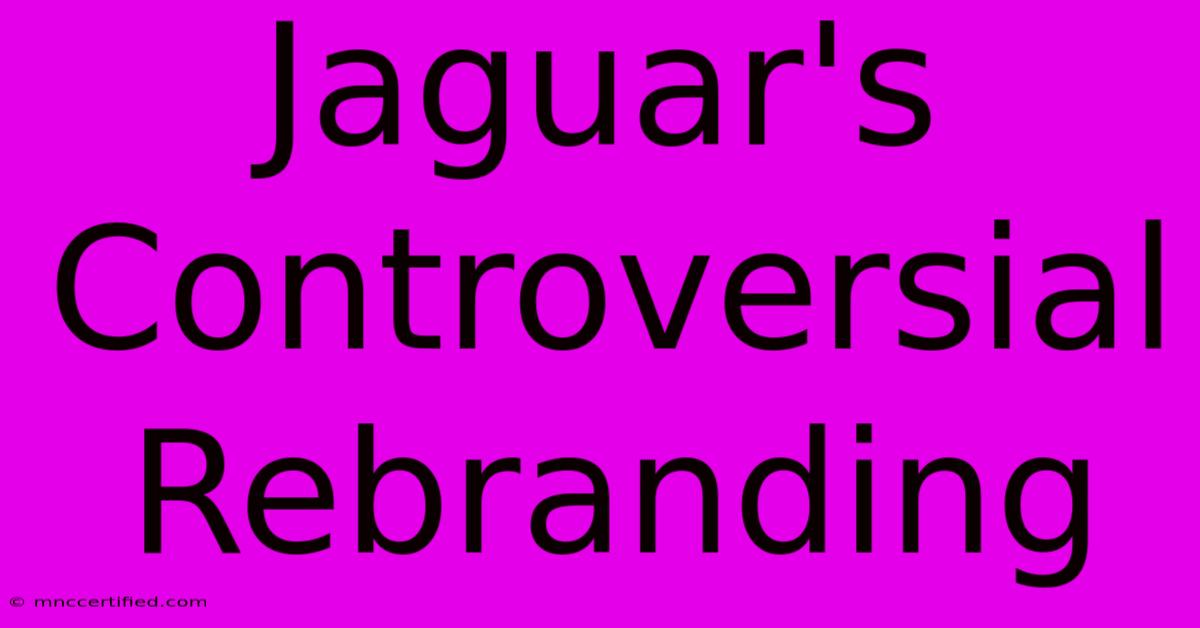Jaguar's Controversial Rebranding

Table of Contents
Jaguar's Controversial Rebranding: A Roar of Discontent?
Jaguar, the British luxury car manufacturer, recently underwent a significant rebranding, sparking considerable debate amongst car enthusiasts, design critics, and the wider public. This article delves into the specifics of the rebranding, analyzes the reasons behind the change, and examines the largely negative public reaction. We'll explore whether this bold move will ultimately benefit or harm the iconic brand.
The New Jaguar Logo and Identity: A Departure from Tradition
The most striking aspect of the rebranding is the new logo. Gone is the leaping jaguar, a symbol synonymous with the brand for decades, replaced by a minimalist, sans-serif "JAGUAR" wordmark. This sleek, modern design prioritizes simplicity and a clean aesthetic, reflecting a broader shift towards a more minimalist design language seen in many contemporary brands. Alongside the new logo, Jaguar also unveiled a revised color palette and typography, further distancing itself from its historical identity.
Why the Change? Jaguar's Strategic Reasoning
Jaguar's justification for this radical rebranding centers on its ambitious goal of becoming a fully electric brand by 2025. The company argues that the old logo, while iconic, felt outdated and didn't accurately reflect its modern vision and commitment to electric vehicles. The new branding, they claim, is cleaner, more contemporary, and better suited to appeal to a younger, more technologically savvy audience. They also highlighted a need to streamline their brand identity across all platforms and marketing materials. This strategy aligns with broader industry trends where legacy brands are refreshing their image to remain relevant in a rapidly evolving market.
The Backlash: A Public Outcry
Despite Jaguar's intentions, the rebranding has been met with significant public criticism. Many long-time Jaguar enthusiasts express disappointment and even anger at the abandonment of the leaping jaguar logo. This symbol held deep emotional resonance for them, representing a rich history and heritage. The perception is that the new branding lacks character and fails to capture the essence of the Jaguar brand. Online forums and social media are awash with negative comments, highlighting a strong sense of disconnect between the company's vision and its loyal customer base.
Analysis of the Negative Reaction: What Went Wrong?
Several factors contribute to the negative reaction:
- Loss of Heritage: The abandonment of the iconic leaping jaguar logo is perceived as a betrayal of the brand's heritage and history.
- Lack of Emotional Connection: The minimalist design, while modern, lacks the emotional impact and powerful symbolism of the previous logo.
- Poor Execution: Some critics argue that the rebranding feels rushed and lacks a cohesive strategy, leading to inconsistencies in its application.
- Ignoring Customer Feedback: The lack of meaningful engagement with customers before implementing the rebranding further fueled the negative sentiment.
The Future of Jaguar: Can the Rebranding Succeed?
The success or failure of Jaguar's rebranding remains to be seen. While the company's strategic reasoning is understandable, the overwhelmingly negative public reaction raises concerns. The company needs to carefully consider the feedback and potentially adjust its approach. A successful rebranding requires not only a visually appealing design but also a strong understanding and respect for the brand's history and its connection with its customer base.
Future strategies might include:
- Improved communication: Jaguar needs to better explain the reasoning behind the rebranding and engage more meaningfully with its customers.
- Gradual transition: A more gradual phasing out of the old logo might have lessened the impact of the change.
- Maintaining heritage elements: Finding ways to subtly incorporate elements of the past into the new branding could help bridge the gap between tradition and modernity.
Only time will tell if Jaguar's bold move will ultimately pay off. The rebranding presents a significant challenge, requiring careful navigation of the delicate balance between innovation and respecting established brand equity. The controversy surrounding the rebranding highlights the importance of thorough market research and genuine engagement with customers when undertaking such significant changes.

Thank you for visiting our website wich cover about Jaguar's Controversial Rebranding. We hope the information provided has been useful to you. Feel free to contact us if you have any questions or need further assistance. See you next time and dont miss to bookmark.
Featured Posts
-
Insurance Companies In Elmira Ny
Nov 21, 2024
-
Term Life Insurance Las Vegas Nv
Nov 21, 2024
-
Liability Insurance And Iscovery
Nov 21, 2024
-
Milady Meme Coin Reach 1 Dollar
Nov 21, 2024
-
Aami Home And Contents Insurance
Nov 21, 2024